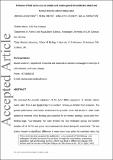Files in this item
Influence of feed ration size on somatic and muscle growth in landlocked dwarf and farmed Atlantic salmon Salmo salar
Item metadata
| dc.contributor.author | Andersen, Øivind | |
| dc.contributor.author | Vieira, Vera | |
| dc.contributor.author | Dessen, Jens-Erik | |
| dc.contributor.author | Johnston, Ian A. | |
| dc.date.accessioned | 2020-03-18T00:33:13Z | |
| dc.date.available | 2020-03-18T00:33:13Z | |
| dc.date.issued | 2019-04 | |
| dc.identifier | 257988095 | |
| dc.identifier | 829de309-2809-4e38-bde4-98d49555ec04 | |
| dc.identifier | 85064216195 | |
| dc.identifier | 000466180500008 | |
| dc.identifier.citation | Andersen , Ø , Vieira , V , Dessen , J-E & Johnston , I A 2019 , ' Influence of feed ration size on somatic and muscle growth in landlocked dwarf and farmed Atlantic salmon Salmo salar ' , Journal of Fish Biology , vol. 94 , no. 4 , pp. 614-620 . https://doi.org/10.1111/jfb.13942 | en |
| dc.identifier.issn | 0022-1112 | |
| dc.identifier.other | RIS: urn:70A92BF8253C08D6EEEBB8A50C370900 | |
| dc.identifier.other | ORCID: /0000-0002-7796-5754/work/55643767 | |
| dc.identifier.uri | https://hdl.handle.net/10023/19668 | |
| dc.description.abstract | We examined the possible adaptation of the dwarf Bleke population of Atlantic salmon Salmo salar from Lake Byglandsfjord in southern Norway to limited food resources. The growth performance and muscle development in juvenile Bleke and farmed S. salar under satiated or restricted (50%) feeding were examined for 10 months, starting 3 weeks after first‐feeding stage. Four‐thousand fish were divided into four replicated groups and random samples of 16–40 fish per group were measured six times during the experiment. The two strains showed no significant difference in mean body mass when fed restricted ration, but the individual variation was considerably higher in the farmed fish. Both Bleke and farmed S. salar grew significantly faster when fed to satiation, but the farmed S. salar showed much higher gain in mass and were three times heavier (201.5 g v. 66.7 g) and possessed twice as many fast muscle fibres (179682 v. 84779) compared with landlocked S. salar after 10 months. Farmed fish fed full ration displayed both hypertrophic and hyperplasic muscle growth, while the increased growth in Bleke S. salar was entirely associated with a larger fibre diameter. The landlocked Bleke strain has apparently adapted to low food availability by minimising the metabolic costs of maintenance and growth through reduced dominance hierarchies and by an increase in average muscle fibre diameter relative to the ancestral condition. | |
| dc.format.extent | 7 | |
| dc.format.extent | 2513646 | |
| dc.language.iso | eng | |
| dc.relation.ispartof | Journal of Fish Biology | en |
| dc.subject | Adaptation | en |
| dc.subject | Dwarfism | en |
| dc.subject | Feed restriction | en |
| dc.subject | Hypertrophy | en |
| dc.subject | Landlocked salmon | en |
| dc.subject | Muscle fibre | en |
| dc.subject | QH301 Biology | en |
| dc.subject | SH Aquaculture. Fisheries. Angling | en |
| dc.subject | NDAS | en |
| dc.subject.lcc | QH301 | en |
| dc.subject.lcc | SH | en |
| dc.title | Influence of feed ration size on somatic and muscle growth in landlocked dwarf and farmed Atlantic salmon Salmo salar | en |
| dc.type | Journal article | en |
| dc.contributor.institution | University of St Andrews. School of Biology | en |
| dc.contributor.institution | University of St Andrews. Marine Alliance for Science & Technology Scotland | en |
| dc.contributor.institution | University of St Andrews. Scottish Oceans Institute | en |
| dc.contributor.institution | University of St Andrews. Centre for Research into Ecological & Environmental Modelling | en |
| dc.identifier.doi | 10.1111/jfb.13942 | |
| dc.description.status | Peer reviewed | en |
| dc.date.embargoedUntil | 2020-03-18 |
This item appears in the following Collection(s)
Items in the St Andrews Research Repository are protected by copyright, with all rights reserved, unless otherwise indicated.

